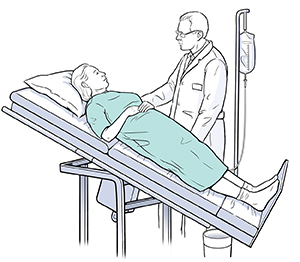Having a (Video) Urodynamics Study
Urodynamic studies are tests that evaluate the bladder, sphincters, and urethra and their ability to store and release urine. They may be done in your healthcare provider’s office, a clinic, or a hospital. The studies may take up to 1 hour or longer. This depends on which tests you have. The tests are generally painless. A small tube (catheter) will be placed into your bladder and in your rectum. You won’t need sedating medicine.
 |
| The equipment used for the study varies depending upon the facility and what tests are done. |
Tests that may be done
-
Uroflowmetry. This measures the amount and speed of urine you void from your bladder. You pee into a funnel. It’s attached to a computer that records your urine flow over time. The amount of urine left in your bladder after you pee may also be measured right after this test.
-
Cystometry. This test evaluates how much your bladder can hold. It also measures how strong your bladder muscle is. And how well the signals work that tell you when your bladder is full. Your healthcare provider fills your bladder with sterile water or saline solution, through a catheter. Your provider will instruct you to report any sensations you feel. Mention if they’re similar to symptoms you’ve felt at home. Your provider may ask you to cough, stand and walk, or bear down during this test.
-
Electromyogram. This helps evaluate the muscle contractions that control urination, such as sphincter muscle contractions. Your healthcare provider may put electrode patches or wires near your rectum or urethra to make the recording. They may ask you to try to tighten or relax your sphincter muscles during this test.
-
Pressure flow study. This test measures your detrusor, urethral, and abdominal pressures. Detrusor is the muscle around the bladder walls. It relaxes to let your bladder fill. And it contracts to squeeze out urine. A pressure flow study is often done after cystometry. You’re asked to pee while a probe in your urethra measures pressures.
-
Video cystourethrography. This takes video pictures of urine flow through your urinary tract. It can help find blockages or other problems. The bladder is filled with an X-ray contrast fluid. Then X-ray video pictures are taken as the fluid is urinated out. Ultrasound imaging may also be combined with routine urodynamic studies.
-
Ambulatory urodynamics. This test can be used to evaluate you while doing normal activities.
Getting your results
After the study, you’ll get dressed and return to the consultation room. Test results may be ready soon after the study is finished. Or you may go back to your healthcare provider’s office in a few days for your results. You can talk with your provider about the study report and your treatment options.
© 2000-2025 The StayWell Company, LLC. All rights reserved. This information is not intended as a substitute for professional medical care. Always follow your healthcare professional's instructions.